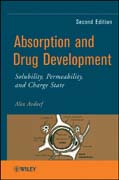
Absorption and drug development: solubility, permeability, and charge state
Avdeef, Alex
This book explains how to examine a compound's pharmaceutical properties, emphasizing oral absorption, detailing different physicochemical methods and how to interpret results for analyzing drug candidates. Now in a new edition, thisupdated volume now includes more case examples, more entries into properties data tables, updated references, and extensive compilations of solubility, permeability, and pKas. With over 600 references and 100 drawings, this book is well-suited for the practical pharmaceutical chemist and those seeking a betterunderstanding of physicochemical measurements. INDICE: Preface to the Second EditionPreface to the First EditionAcronymsNomenclature1. Introduction1.1 Bulldozer Searching for a Need in the Haystack?1.2 As the Paradigm Turns1.3 Screen for the Target or ADME First?1.4 ADME and Multi-Mechanism Screens1.5 ADME and the Medicinal Chemist1.6 The ‘Absorption’ of ADME1.7 It is Not Just a Number - It is a Multi-Mechanism2. Transport Model2.1 Permeability-Solubility-Charge State and pH-Partition Hypothesis2.2 Properties of the Gastrointestinal Tract (GIT)2.3 pH Microclimate2.4 Intracellular pHEnvironment2.5 Tight Junction Complex2.6 Structure of Octanol2.7 Biopharmaceutics Classification System3. pKa Determination3.1 Charge State and the pKa3.3 Titration with a Glass-Membrane pH Electrode3.4 Equilibrium Equations and the Ionization Constant3.5 ‘Pure Solvent’ Activity Scale3.6 Ionic Strength and Debye-Hückel/Davies Equation3.7 ‘Constant Ionic Medium’ Activity Scale3.8 Temperature Dependence of pKa Values3.9 Electrode Calibration and Standarization3.10 Bjerrum Plot - Most Useful Graphical Tool in pKa Analysis3.11 Cosolvent Methodfor pKa Determination of Practically-Insoluble Substances3.12 Other Methods for pKa Measurement3.13 pKa Microconstants3.14 pKa Compilations3.15 pKa Prediction Programs3.16 Database of pKa (25°C and 37°C)4. Octanol-Water Partitioning4.1 Overton-Hansch Model4.2 Tetrad of Equilibria4.3 Conditional Constants4.4 log P Data Sources4.5 log D Lipophilicity Profile4.6 Ion-Pair Partitioning4.7 Micro-log P4.8 Methods for log P Determination4.9 Dyrssen Dual-Phase Titration log P Method4.10 Ionic Strength Dependence of log P4.11 Temperature Dependence of log P4.12 Calculated vs. Measured log P of Research Compounds4.13 log D vs.pH Case Study: Procaine Structural Analogs4.14 Database of Octanol-Water log PN, log P1, and log D7.45. Liposome-Water Partitioning5.1 Biomimetic Lipophilicity5.2 Tetrad of Equilibria and Surface Ion -Pairing (SIP)5.3 Data Sources5.4Location of Drugs Partitioned into Bilayers5.5 Thermodynamics of Partitioning: Entropy- or Enthalpy-Driven?5.6 Electrostatic and Hydrogen Bonding in a Low Dielectric Medium5.7 Water Wires, H+/OH- Currents, and Permeability of Amino Acids and Peptides5.8 Preparation Methods: MLV, SUV, FAT, LUV, ET5.9 Experimental Methods5.10 Prediction of log Pmem from log Poct5.11 log Dmem, diff log Pmem, and Prediction of log Psipmem from log P1oct5.12 Three Indices of Lipophilicity: Liposomes, IAM, and Octonal5.13 Getting It Wrong from One-Point log DmemMeasurement5.14 Partitioning into Charged Liposomes5.15 pKamem Shifts in Charged Liposomes and Micelles5.16 Prediction of Absorption from Liposome Partition Studies?5.17 Database of log pmem and log Psipmem6. Solubility6.1 It’s Not Just a Number6.2 Why is Solubility Measurement Difficult?6.3 Mathematical Models for Solubility-pH Profiles6.4 Experimental Methods6.5 Correction for the DMSO Effect by the ‘A-Shift’ Method6.6 Case Studies (Solubility-pH Profiles)6.7 Limits of Detection - Precision vs. Accuracy6.8 Data Sources and the ‘Ionizable-Drug Problem’6.9 Database of log S07. Permeability - Pampa7.1 Permeability inthe Gastrointestinal Tract7.2 Historical Developments in Permeability Models7.3 Rise of Pampa - a Useful Tool in Early Discovery7.4 PAMPA-HDM, -DOPC, -DS Models Compared7.5 Modeling Biological Membranes7.6 Permeability-pH Relationship and the Mitigating Effect of the Aqueous Boundary Layer7.7 pKaFlux - Optimized Design (pOD)7.8 Cosolvent PAMPA7.9 UV vs. LS/MS Detection7.10 Assay Time Points7.11 Buffer Effects7.12 Apparent Filter Porosity7.13 PAMPA Errors: Intra-Plate and Inter-Plate Reproducibility7.14 Human Intestinal Absorption (HIA) andPAMPA7.15 Permeation of Permanently Charged Molecules7.16 Permeation of Zwitterions/Ampholytes - in combo PAMPA7.17 PAMPA on Formulation - Solubilization Excipient Effects7.18 Database of Double-Sink PAMPA log Po,log Pm6.5, log Pm7.48. Permeability - Caco-2/MDCK8.1 Permeability in the Gastrointestinal Tract 8.2 Cell-Based in vitro Permeability Model8.3 in situ Human Jejunum Permeability (HJP) Model8.4 Intrinsic Permeability Coefficients of Caco-2 and MDCK Compared8.5 Theory (Stage 1): Paracellular Leakiness and Size Exclusion in Caco-2, MDCK, and 2/4/A1 Cell Lines8.6 Theory (Stage2): Regression Method for in vitro Cellular Permeability8.7 Case Studies of Cell-Based Permeability as a Functionof pH8.8 Human Jejunal Permeability Predicted Directly from Caco-2/MDCK8.9 Caco-2/MDCK Database and its in combo PAMPA Prediction9. Permeability - Blood-Brain Barrier9.1 The Blood-Brain Barrier: A Key Element for the Drug Access to the Central Nervous System Drugs9.2 The Blood-Brain Barrier9.3 Non-Cellular BBBModels9.4 in vitro Cell-Based Models9.5 in vivo BBB Models9.6 Paradigm Shift9.7 in silico BBB Models9.8 Biophysical Analysis of in vitro Endothelial Cell Models9.9 in situ Brain Perfusion Analysis of Flow9.10 in combo PAMPA-BBB Modelfor Passive Permeability10. Summary and Some Simple ApproximationsIndex
- ISBN: 978-1-118-05745-2
- Editorial: John Wiley & Sons
- Encuadernacion: Cartoné
- Páginas: 744
- Fecha Publicación: 01/06/2012
- Nº Volúmenes: 1
- Idioma: Inglés
